The product innovation process is a framework that helps companies launch new products and improve existing ones.
By implementing an effective product innovation process, companies can:
Pinpoint product weaknesses and introduce improvements, sustaining innovation and driving business growth.
Identify customer pain points beyond their current product offering and launch new products that address those needs, expanding into adjacent markets and new technologies.
With over 10 years of experience managing product innovation across multiple companies, we’ve helped businesses source high-quality ideas from employees and customers and establish steps to evaluate, validate, and implement them.
We’ve compiled this guide detailing the product innovation process we recommend companies use.
Book a 25-minute demo to learn how InnovationCast can help you establish a product innovation process.
Step 1: Crowdsource Customer Pain Points and Solutions to Those Pain Points
The first step in the product innovation process is identifying product shortcomings, unmet customer needs, or new market opportunities, along with potential solutions. Many companies achieve this by crowdsourcing ideas from employees, customers, and other innovation participants.
While we endorse crowdsourcing, the way you crowdsource ideas matters.
Many companies approach crowdsourcing by creating a Microsoft Teams or Slack channel, a suggestion box of sorts, and asking employees to share anything that comes to mind.
This ideation approach presents a few problems:
Employees are unaware of customer expectations and pain points, so they submit ideas that don't address actual needs.
Employees submit generic, low-effort product ideas, such as "Let's add an AI feature," which companies must table.
Employees don't recognize that product innovation is the company's priority, so they focus on ideas related to their day-to-day tasks, making it difficult for companies to collect relevant product ideas.
There are three key pieces to solving these issues:
Companies should establish a continuous feedback loop that enables customers to highlight pain points, identify unmet needs, and suggest product improvements. These insights can help shape the company’s product innovation strategy.
Companies must collaborate with customers to uncover meaningful problems worth solving. This builds trust and results in more honest customer feedback.
Companies should share these insights with employees and encourage them to brainstorm ideas — whether for incremental innovation or disruptive innovation — that address the identified pain points.
How InnovationCast Enables Companies to Collect High-Quality Product Ideas
With our “Always On” idea collection feature, companies can ask customers to share product shortcomings as well as unmet needs that fall outside the scope of their existing products.

Companies can then use Innovation Challenges to source solutions specific to those insights.
Innovation Challenges are time-limited calls for ideas focused on particular topics. Companies can create a challenge containing market research, product shortcomings, and unmet needs that customers surface with “Always On.”
InnovationCast informs all employees to review the challenge details and brainstorm solutions.
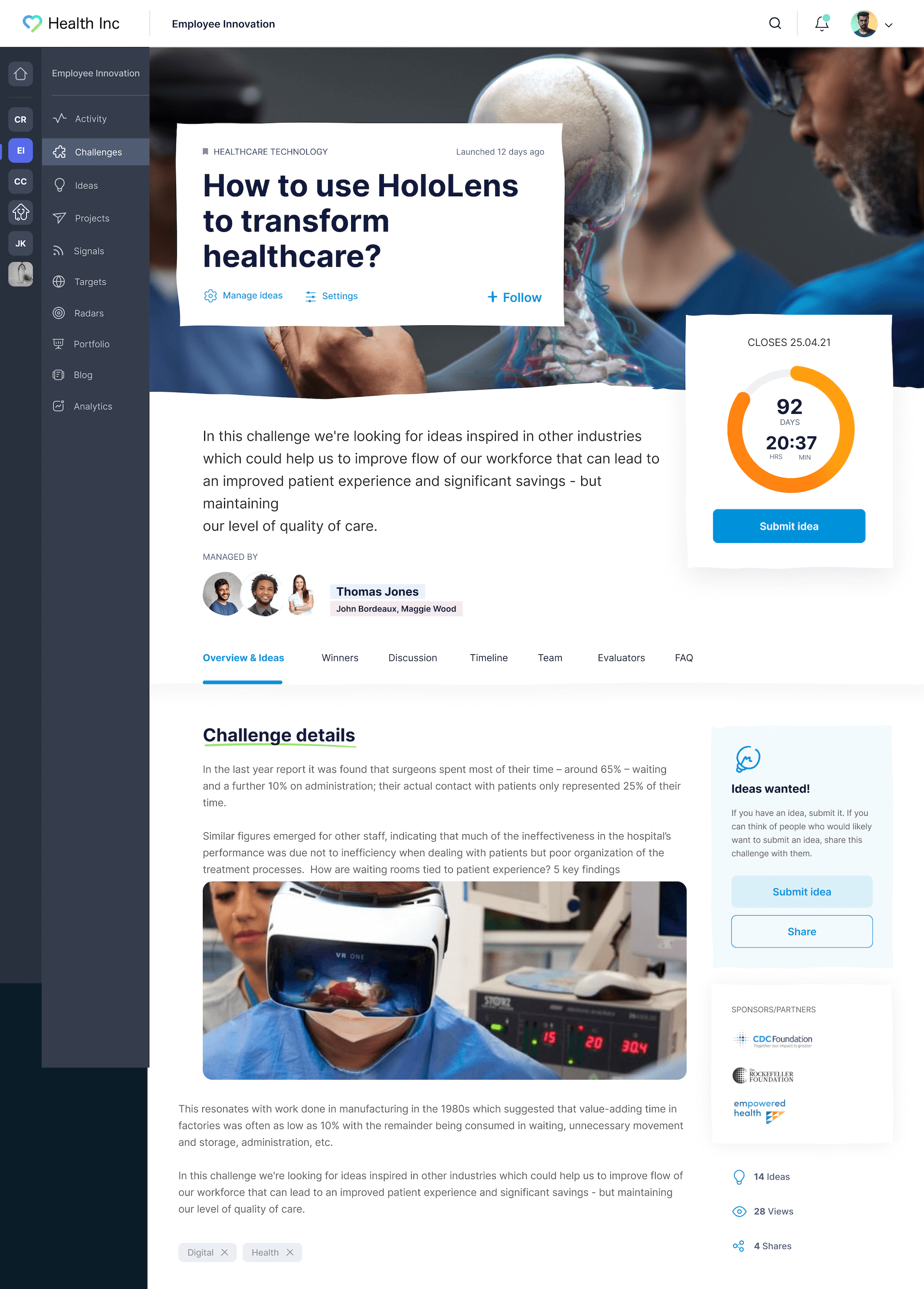
Read more: How to Implement an Effective Idea Generation Process in Your Organization
Step 2: Improve Product Ideas Using the Expertise of the Entire Workforce
Many organizations send product ideas for evaluation immediately after they’ve been submitted.
We don’t recommend this because first-draft ideas are rarely fully developed and ready to evaluate. Even the most promising ideas often have flaws or gaps that the original author must address (e.g., compliance issues, unclear value propositions, weak differentiation).
Companies with the most effective product innovation processes incorporate an improvement step, where the entire workforce can review idea submissions and apply their expertise to iterate upon them.
This approach engages specialists across several areas of expertise, including legal, marketing, finance, and engineering, to improve product ideas, leaving idea evaluators with more complete concepts.
Unfortunately, with the way most companies manage product innovation, this step isn’t possible. There isn’t a central idea management system where innovation participants can view ideas and easily collaborate. Instead, only idea evaluators can view submissions.
To remedy this, we recommend companies use an innovation management system to centralize ideas.
How InnovationCast Improves Ideas Using the Knowledge of the Entire Workforce
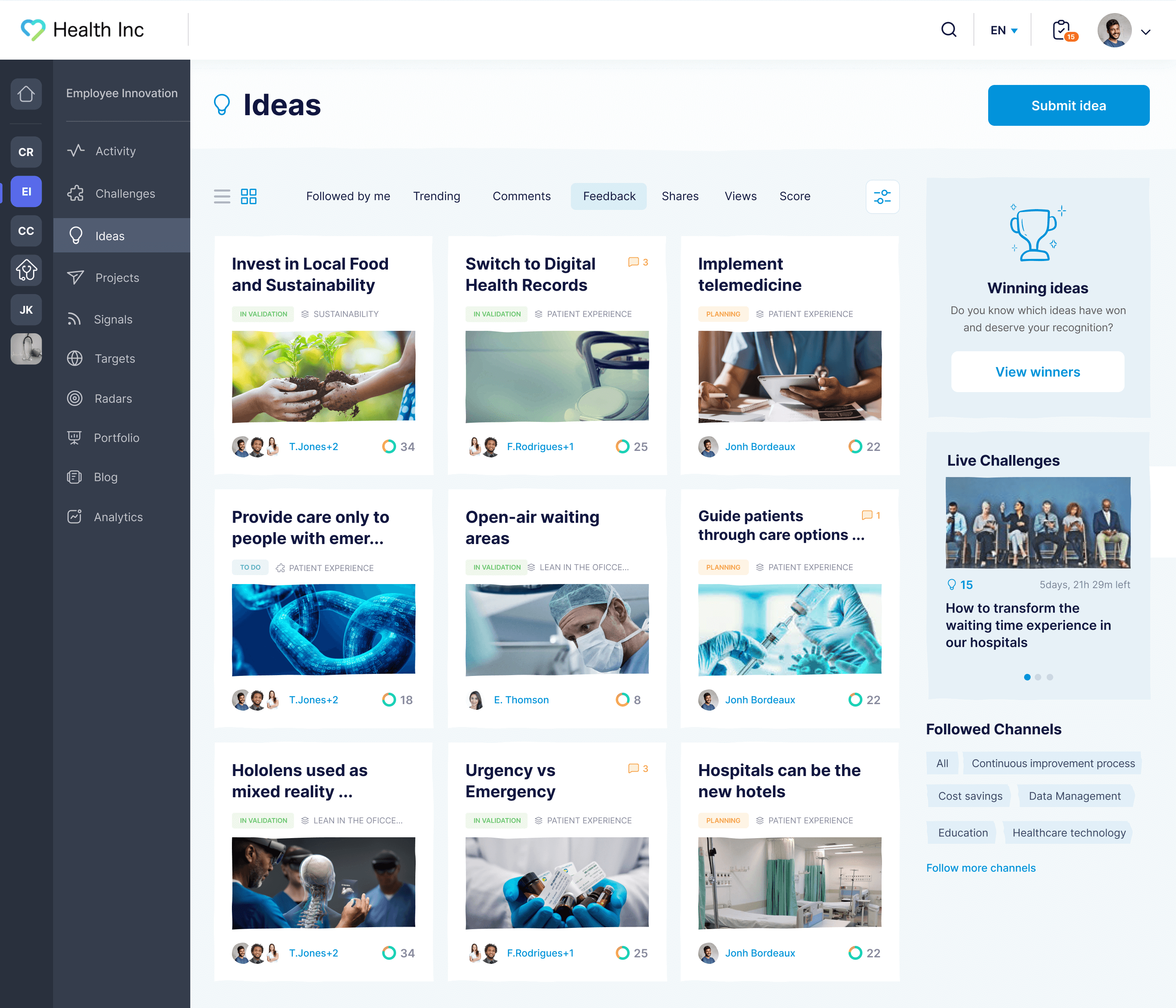
Anyone from any department can see all idea submissions when they sign into their InnovationCast dashboard.
Users can share their thoughts on an idea by voting and offering constructive feedback to help the author refine it. This enables companies to improve ideas using the expertise of their entire workforce.
Read more: How to Encourage Innovation in the Workplace
Step 3: Evaluate Product Ideas and Determine Which to Move Forward With
Once ideas are refined, they are reviewed by an evaluator, typically a product manager, who uses their expertise to determine whether the idea is worth developing further.
For continuous improvement ideas, scoring systems can help guide evaluators’ decision-making. We’ve learned that scoring systems like impact-effort matrices, feasibility-desirability-viability assessments, and weighted scoring models all work well.
However, for new product ideas that carry significant risk and uncertainty, evaluators are likely unable to score ideas on a scale from zero to 10, as the necessary data to make decisions may not yet be available.
In these scenarios, evaluators have internal discussions with stakeholders to decide whether to give the greenlight. This decision is based on factors such as company priorities, potential risks, and value propositions. If the idea is approved, it undergoes validation before the entire product is launched (more on idea validation below).
However, idea evaluators may not always know the best approach to evaluating ideas, as different ideas naturally require different methods. That’s why we designed InnovationCast to provide guidance on the evaluation process.
Read more: Best Practices to Evaluate Innovation Ideas
InnovationCast Contains Everything Needed to Evaluate Ideas
With InnovationCast, evaluators access evaluation models, criteria, scoring and rating systems, and scorecards needed to assess ideas.
InnovationCast suggests using distinct models, criteria, and scoring systems for different types of innovation, (e.g., user experience innovation, incremental improvements, business model innovation). This helps evaluators make informed decisions without needing to create their own framework.
Here’s an example of a scoring system inside InnovationCast:
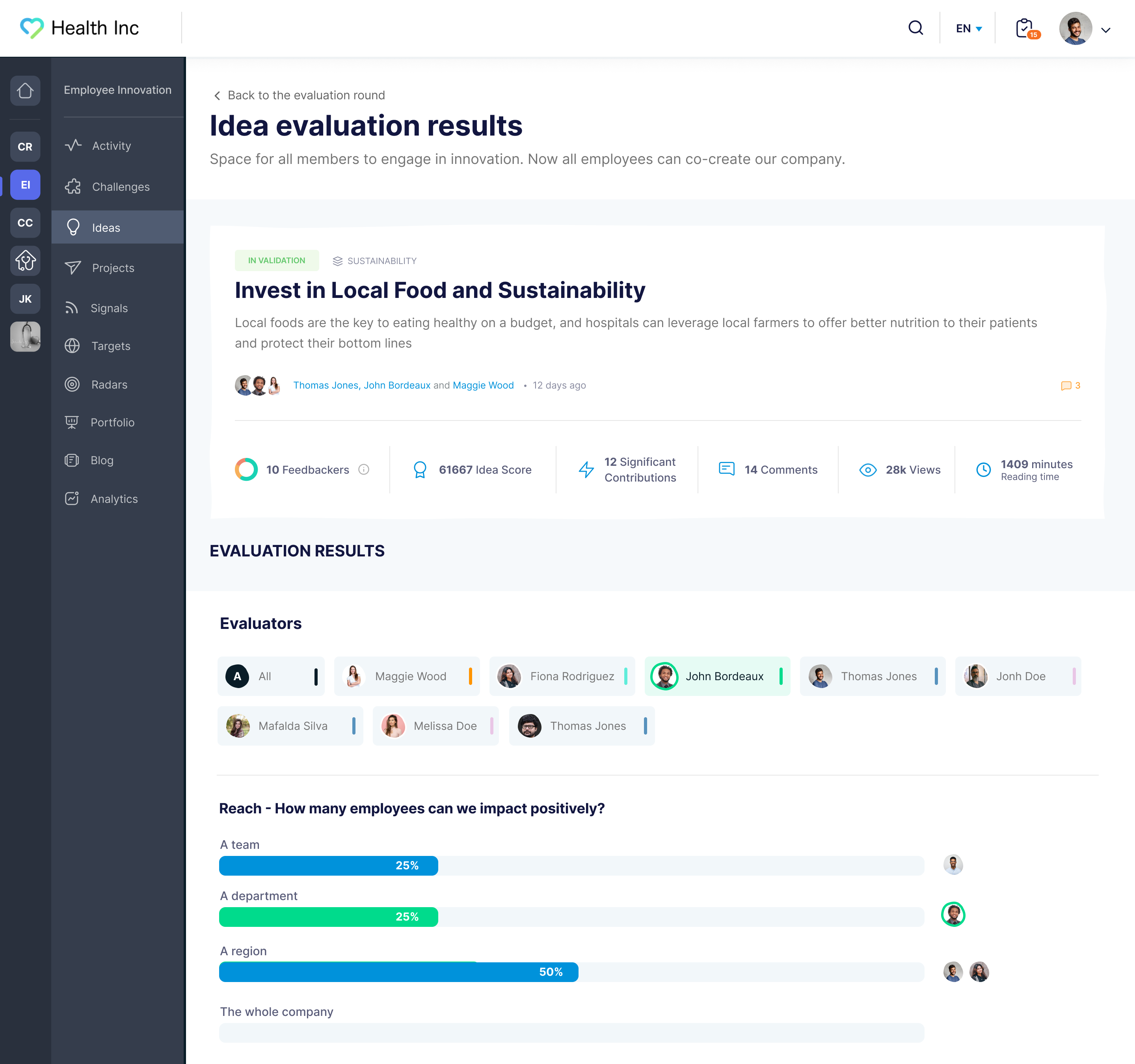
Step 4: Prioritize the Most Impactful Ideas
Companies will likely have multiple product ideas pass through evaluation.
However, implementing every idea at once is unrealistic. Companies need their top talent — product managers, engineers, and designers — to validate and implement product ideas, essentially creating a mini-company for each one. At the same time, these individuals must manage day-to-day operations.
This means top management must balance overseeing day-to-day operations with testing product ideas, which is where idea prioritization comes in.
When prioritizing ideas, top management decides which are the most impactful and can address the company's most urgent priorities. Those ideas are implemented first.
For continuous improvement ideas, prioritization is straightforward because evaluators will use the scoring results from Step 3 to implement ideas with the highest scores first.
The prioritization step is more nuanced for new technological advancements where the evaluator couldn't score the idea. It requires top management to have an open conversation about ideas, considering factors like market potential, technical feasibility, and customer impact before making a decision.
InnovationCast Allows Decision Makers and Stakeholders to Vote on Which Ideas to Prioritize
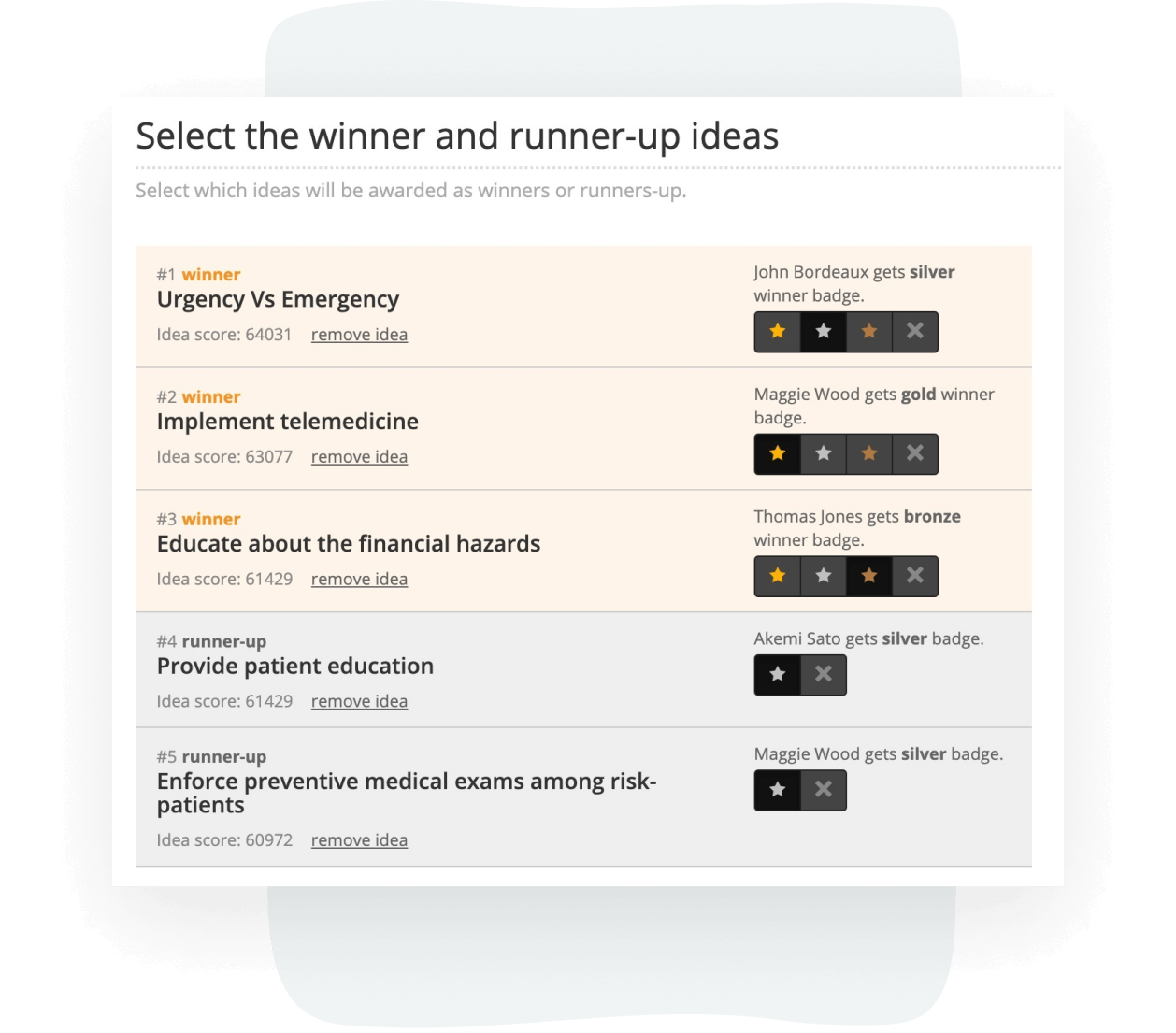
InnovationCast offers a voting functionality that enables stakeholders to view the evaluation results of all ideas and vote on which are “Winners” and “Runners Up.”
Then, the winning ideas are moved to validation or implementation, while the runners-up remain on hold for later consideration.
Step 5: Validate New Product Ideas to Reduce Uncertainty & Risk
New product ideas inherently carry uncertainty and risk, so companies validate them before implementation. Through validation, they work to reduce these factors to a level that justifies investing resources into launching the full product.
Validation typically involves mapping out assumptions — statements detailing what must be true for the new product idea to work — and running experiments to test whether those assumptions are valid.
Here are a few examples of experiments companies use to test various assumptions:
Assumption: There’s a desire for this product.
Experiment: Create a landing page describing the product idea, including a call-to-action (e.g., "Sign up for early access"), to measure customer interest.
Assumption: The product concept effectively addresses the target problem.
Experiment: Build a simple prototype and conduct user testing with focus groups to determine if the concept effectively addresses the problem.
Assumption: Certain features will be more valuable to potential users.
Experiment: Set up A/B testing for new features to identify which resonates most with potential users.
Companies manage validation by forming a dedicated team — typically including the original author, a designer, a marketer, and an engineer — and providing them with a limited budget and timeframe to test key assumptions.
The validation team first tests the highest-risk, highest-uncertainty assumptions ( i.e., those that could jeopardize the project if proven invalid). If those assumptions are validated, top management provides more budget to test the next set of assumptions. This process continues until all assumptions are validated and uncertainty is reduced to an acceptable level.
A common mistake is assuming that validation teams can figure out the process on their own. Since these teams often consist of developers and marketers, rather than innovation managers, they rarely know how to effectively test ideas.
Innovation managers must provide direction and support throughout the validation process to ensure ideas are properly tested.
Read more: Idea Validation: A Guide to Affordably Testing Ideas
InnovationCast Guides Validation Teams Through the Steps to Validate Ideas
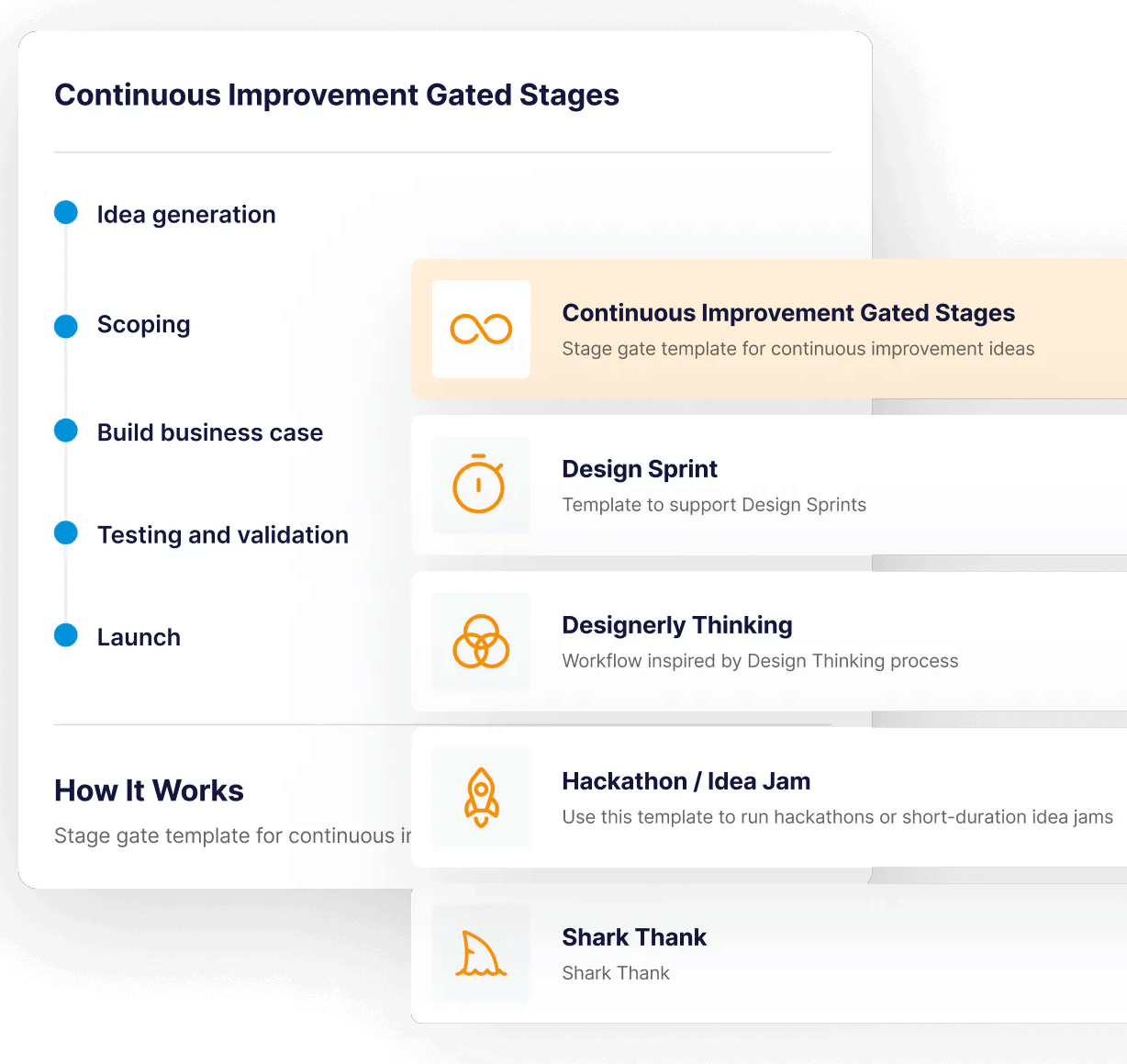
InnovationCast offers multiple workflows that outline the steps validation teams must follow to successfully validate radical innovations. These workflows detail the assumptions to map out, the experiments to conduct, and the KPIs to measure.
This provides validation teams with clear guidance on testing ideas, allowing the innovation department to avoid micromanaging each validation project.
Having overseen countless validation projects, our workflows are based on our experience as innovation managers and incorporate best practices from methodologies like New Product Development, Jobs to be Done, and Lean Startup.
Step 6: Develop and Launch the Full Product
While validation teams aren’t responsible for implementing product ideas, they play a key role in the product innovation process. After stakeholders have reviewed and approved ideas for development, the validation team hands them over to the project management office for implementation.
The project management office then assembles an implementation team and oversees the rollout of the full product. This often involves:
Having the product design team create the full product design.
Creating a project timeline and development process with clear milestones, ensuring everyone understands their responsibilities and deadlines.
Sourcing suppliers for necessary materials and estimating production costs.
Allocating resources — including budget, personnel, and tools — to ensure successful implementation.
Coordinating with customer support to train them on handling potential issues.
Collaborating with marketing teams to create promotional strategies for the product launch.
Partnering with customer success teams to develop onboarding strategies that help users successfully adopt the product.
Step 7: Measure the Progress of the Idea
Although innovation teams aren’t responsible for tracking ideas post-implementation — this typically falls to the product management team — measuring impact is crucial for successful product implementation.
Companies need to track key metrics (e.g., market share, market demand, and sales) to gauge whether products are meeting expectations and identify areas for improvement.
Impact tracking helps companies approach innovation more strategically by reallocating resources to the most successful products.
For more on measuring the impact of innovations, we’ve written an entire article on the topic, which you can read here.
InnovationCast Helps Companies Measure the Impact of Ideas
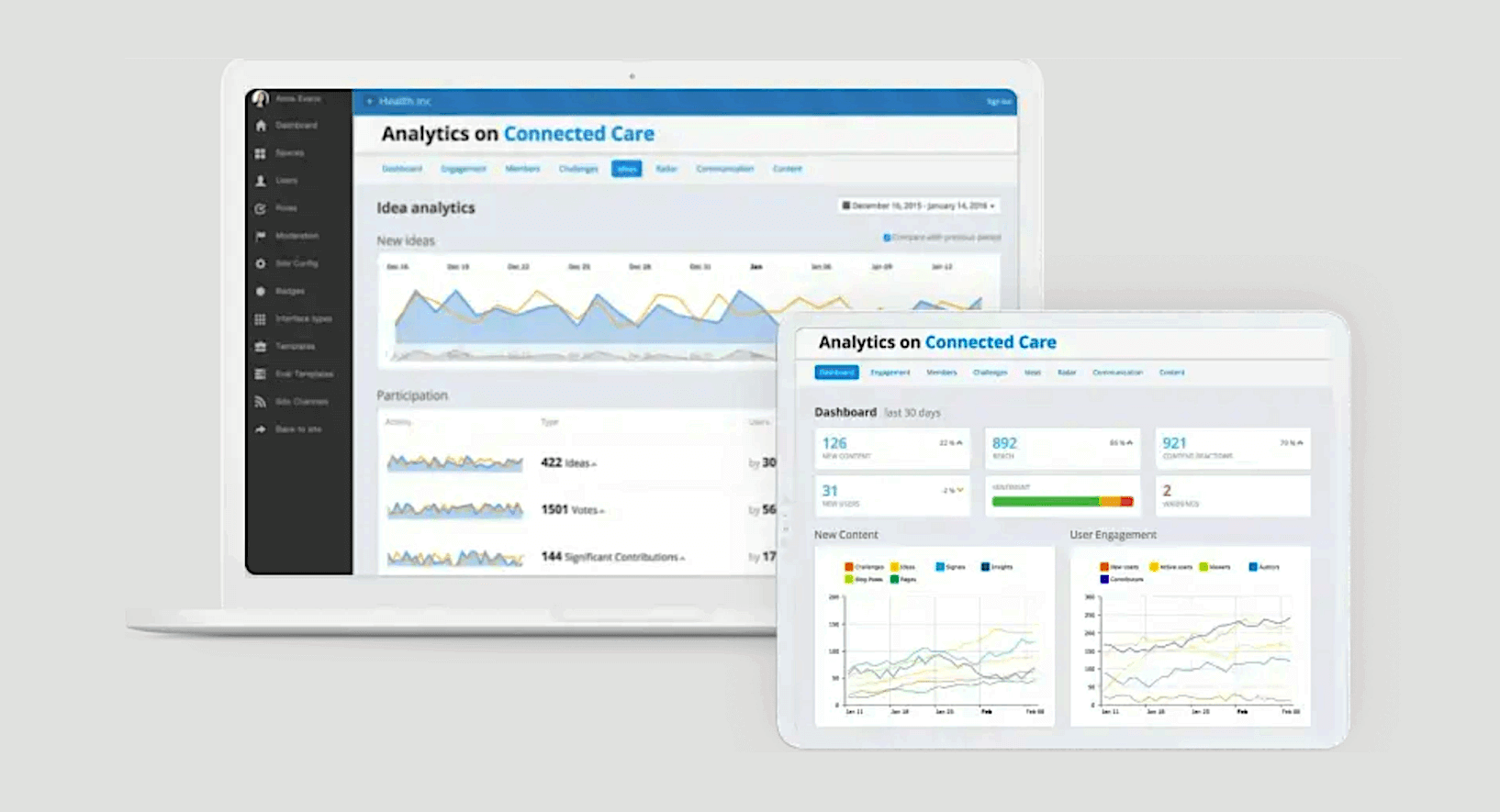
We built InnovationCast with a reporting dashboard that integrates with data visualization tools like Google Charts, Tableau, and Microsoft BI. This enables top management to track all launched products, their implementation costs and the revenue they generate.
Establish a Successful Product Innovation Process with InnovationCast
You can learn more about how InnovationCast helped companies like DHL and Visa launch product innovation processes and gain competitive advantages by scheduling a 25-minute demo.

